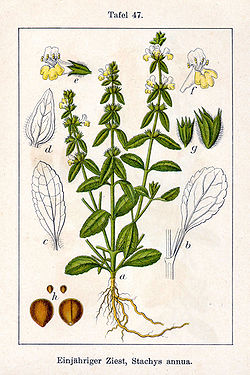| Stachys annua | |
|---|---|
 | |
| Flowers | |
 | |
| Botanical illustration | |
| Scientific classification | |
| Kingdom: | Plantae |
| Clade: | Tracheophytes |
| Clade: | Angiosperms |
| Clade: | Eudicots |
| Clade: | Asterids |
| Order: | Lamiales |
| Family: | Lamiaceae |
| Genus: | Stachys |
| Species: | S. annua |
| Binomial name | |
| Stachys annua | |
| Synonyms [2] | |
List
| |
Stachys annua, called the annual yellow woundwort, is a widespread species of flowering plant in the hedgenettle genus Stachys , native to Europe, the Middle East, and western Siberia, and introduced in Cyprus, eastern North America, and Amur Oblast and Primorsky Krai in far eastern Russia. [2] [3] It is a common plant in fields, road verges and waste places. [4]